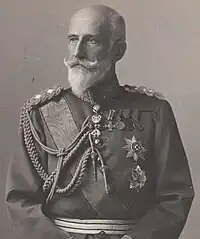Duke Philipp of Württemberg
Philipp, Duke of Württemberg (30 July 1838 – 11 October 1917) was a German prince, head of the Roman Catholic cadet branch of the dynasty which ruled the Kingdom of Württemberg.
| Duke Philipp of Württemberg | |||||
|---|---|---|---|---|---|
 | |||||
| Born | 30 July 1838 Neuilly-sur-Seine, Kingdom of France | ||||
| Died | 11 October 1917 (aged 79) Stuttgart, Kingdom of Württemberg | ||||
| Spouse | Archduchess Maria Theresa of Austria | ||||
| Issue | Albrecht, Duke of Württemberg Duchess Marie Amélie Maria Isabella, Princess of Saxony Duke Robert Duke Ulrich | ||||
| |||||
| House | House of Württemberg | ||||
| Father | Duke Alexander of Württemberg | ||||
| Mother | Princess Marie d'Orléans | ||||
| Religion | Roman Catholicism | ||||
Biography
He was the son of Duke Alexander and of Princess Marie d'Orléans, a daughter of Louis Philippe, King of the French.[1] His mother died when he was a few months old, causing him to be raised by his grandparents in Paris. When he was ten, the Royal family of France had to flee from France, staying in exile in Great Britain.
Duke Philipp became engaged to Duchess Sophie in Bavaria, sister of the Empress Elisabeth of Austria. But the Duke dissolved the engagement. He married Archduchess Maria Theresia and the couple had a splendid palace built at the Ringstrasse in Vienna. They moved in during 1865, but as Duchess Marie Therese never liked the palace it was sold to a banker and investor in 1871. Two years later, the renovated palace was opened on the occasion of the 1873 Vienna World's Fair as the Hotel Imperial. To this day it remains one of the most famous hotels in the world, and while renovated multiple times it has retained many elements of the original neo-Renaissance elements in the Ducal Palace.
After selling their palace in Vienna the couple bought a much smaller city palace named Strudelhof. They had a grand villa built at Altmünster on the shore of the Traunsee, not far away from the Emperor's summer residence at Bad Ischl. Around 1900, the couple moved to Stuttgart where they lived near their sons, at the Prinzenbau.
Upon the death of his cousin Duke Nicholas of Württemberg in 1903,[2] he became heir presumptive to the royal throne of Württemberg until his death in 1917. But he was ten years older than King Wilhelm II of Württemberg, and so his eldest son Duke Albrecht (1865–1939) was considered and raised as the next king. On 29 November 1918 Württemberg's monarchy was abolished in the collapse of the German Empire following World War I, while his kinsman of the senior branch of the dynasty, Wilhelm II, was still king (and lived, after his abdication, until 2 October 1921).[2]
Marriage and issue
In 1865 Philip of Württemberg married Archduchess Maria Theresa of Austria, daughter of Archduke Albert, Duke of Teschen and Princess Hildegard of Bavaria. They had five children:[1]
- Albrecht, Duke of Württemberg (23 December 1865–31 October 1939) he married Archduchess Margarete Sophie of Austria on 24 January 1893. They had seven children.[2]
- Duchess Marie Amélie of Württemberg (24 December 1865-16 December 1883) died at the age of seventeen.
- Duchess Maria Isabella of Württemberg (30 August 1871–24 May 1904) she married Prince Johann Georg of Saxony on 5 April 1894.
- Duke Robert of Württemberg (14 January 1873–12 April 1947) he married Archduchess Maria Immakulata of Austria on 29 October 1900.
- Duke Ulrich of Württemberg (13 June 1877-13 June 1944)
Ducal branch of the royal dynasty
Philip of Württemberg belonged to the fifth branch (called the "Ducal branch") of the House of Württemberg, descended from the seventh son of Frederick II Eugene, Duke of Württemberg.[2] On the extinction of the eldest branch in 1921, the Catholic ducal line remained the only dynastic branch of the formerly reigning family. The House of Württemberg's two morganatic branches - that of the Dukes of Teck (extinct in the male line in 1981), and of the Dukes of Urach - were genealogically senior to the Ducal branch, but had been ineligible to succeed to the throne.[2]
Philip is the direct ancestor of the current claimant to the Kingdom of Württemberg: Wilhelm, Duke of Württemberg.[1]
Honours
 Württemberg:[3]
Württemberg:[3]
- Grand Cross of the Order of the Württemberg Crown, 1852
- Grand Cross of the Friedrich Order
 Austrian Empire:[4]
Austrian Empire:[4]
- Knight of the Order of the Golden Fleece, 1865
- Grand Cross of the Royal Hungarian Order of Saint Stephen, 1900
.svg.png.webp) Kingdom of Bavaria: Knight of the Order of Saint Hubert, 1893[5]
Kingdom of Bavaria: Knight of the Order of Saint Hubert, 1893[5].svg.png.webp) Belgium: Grand Cordon of the Order of Leopold (civil division), 21 July 1861[6]
Belgium: Grand Cordon of the Order of Leopold (civil division), 21 July 1861[6].svg.png.webp) Kingdom of Saxony: Knight of the Order of the Rue Crown, 1894[7]
Kingdom of Saxony: Knight of the Order of the Rue Crown, 1894[7].svg.png.webp)
.svg.png.webp)
.svg.png.webp) Ernestine duchies: Grand Cross of the Saxe-Ernestine House Order, 1864;[8] with Swords[3]
Ernestine duchies: Grand Cross of the Saxe-Ernestine House Order, 1864;[8] with Swords[3] Brunswick: Grand Cross of the Order of Henry the Lion, 1863[9]
Brunswick: Grand Cross of the Order of Henry the Lion, 1863[9].svg.png.webp) Spain: Grand Cross of the Royal and Distinguished Order of Charles III, 10 January 1884[10]
Spain: Grand Cross of the Royal and Distinguished Order of Charles III, 10 January 1884[10]
Ancestry
| Ancestors of Duke Philipp of Württemberg |
|---|
References
- Huberty, Michel; Giraud, Alain; Magdelaine, F.; B. (1979). L'Allemagne Dynastique, Tome II -- Anhalt-Lippe-Wurtemberg. France: Laballery. pp. 499, 527, 542, 554. ISBN 2-901138-02-0.
- Almanach de Gotha, Haus Württemberg (Maison de Wurtemberg). Gotha. Justus Perthes, 1944), pp. 131-132, (French).
- Hof- und Staats-Handbuch des Königreich Württemberg (1908), "Departement des Kriegswesen" p. 224
- "Ritter-Orden", Hof- und Staatshandbuch der Österreichisch-Ungarischen Monarchie, 1917, pp. 50, 55, retrieved 11 September 2020
- Hof- und Staats-Handbuch des Königreich Bayern (1908), "Königliche Orden" p. 9
- "Liste des Membres de l'Ordre de Léopold", Almanach Royal Officiel (in French), 1862, p. 50 – via Archives de Bruxelles
- Sachsen (1901). "Königlich Orden". Staatshandbuch für den Königreich Sachsen: 1901. Dresden: Heinrich. p. 4 – via hathitrust.org.
- Staatshandbuch und Geographisches Ortslexikon für die Herzogthümer Sachsen-Coburg und Gotha (1884), "Herzogliche Sachsen-Ernestinischer Hausorden" p. 31
- Hof- und Staatshandbuch des Herzogtums Braunschweig für das Jahr 1908. Braunschweig 1908. Meyer. p. 9
- "Real y distinguida orden de Carlos III". Guía Oficial de España (in Spanish). 1914. p. 211. Retrieved 23 January 2021.
Further reading
- Ilse Feller and Eberhard Fritz: Württemberg zur Königszeit. Die Fotografen des Herzogs Philipp von Württemberg (1838-1917). Konrad Theiss Verlag, Stuttgart 1990. [German]